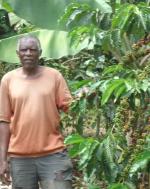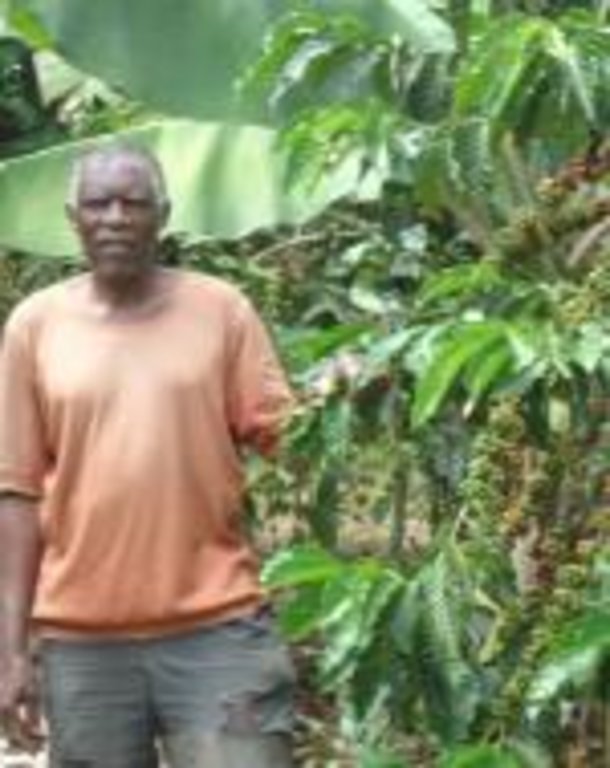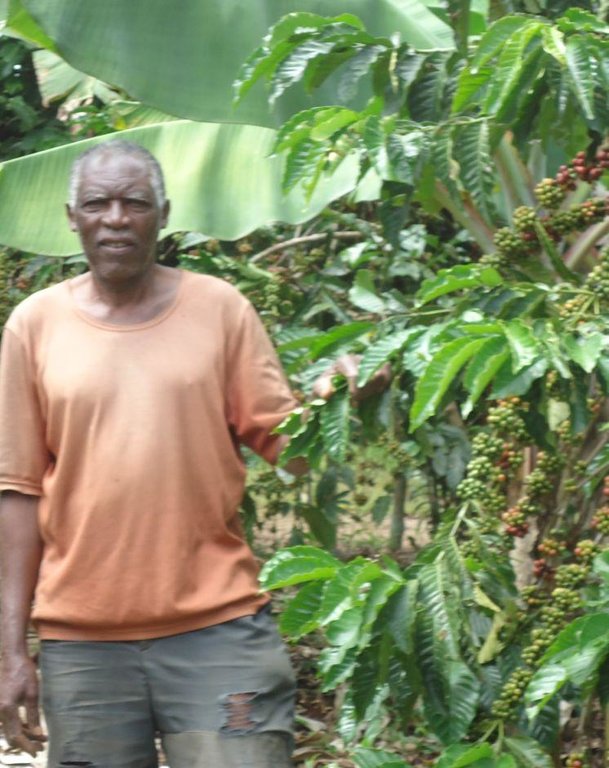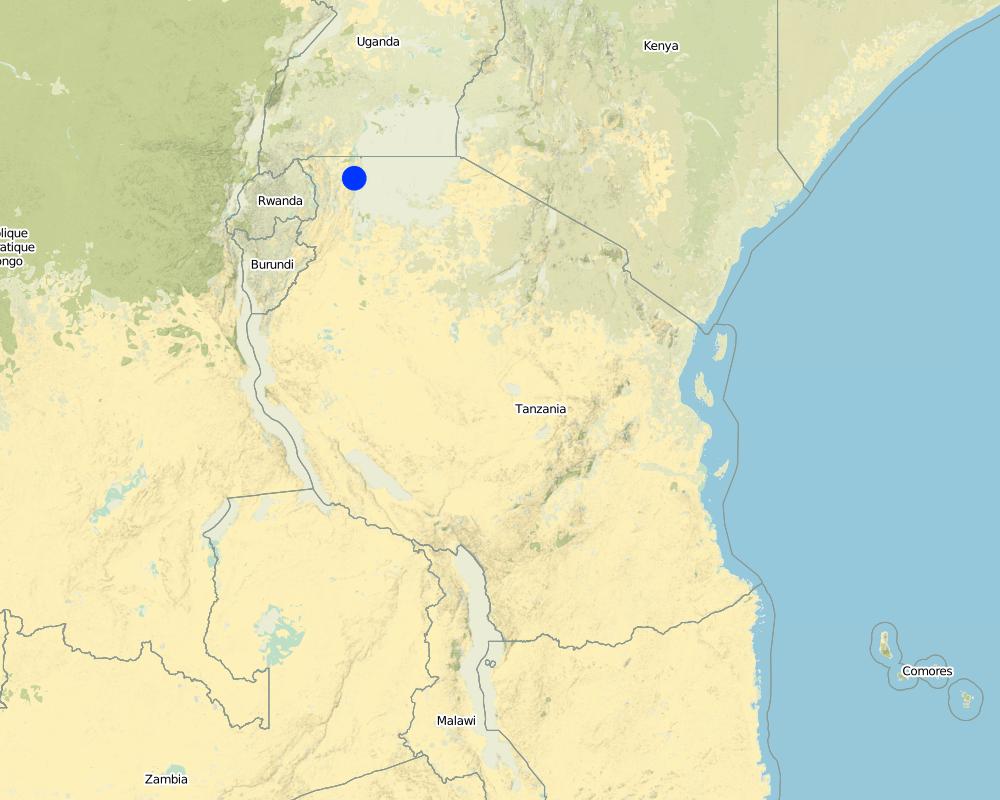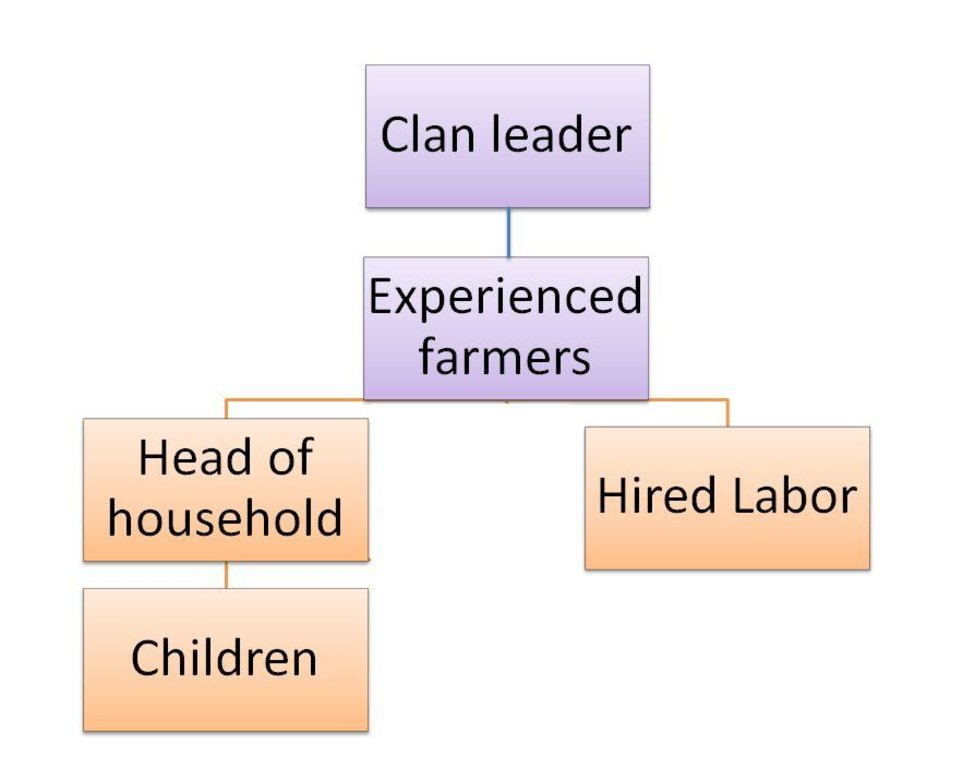Indigenous knowledge transfer [ប្រទេសតង់សានី]
- ការបង្កើត៖
- បច្ចុប្បន្នភាព
- អ្នកចងក្រង៖ Godfrey Baraba
- អ្នកកែសម្រួល៖ –
- អ្នកត្រួតពិនិត្យ Fabian Ottiger
Emikolele n'emyegesheleze. (HAYA)
approaches_2472 - ប្រទេសតង់សានី
ពិនិត្យមើលគ្រប់ផ្នែក
ពង្រីកមើលទាំងអស់ បង្រួមទាំងអស់1. ព័ត៌មានទូទៅ
1.2 ព័ត៌មានលម្អិតពីបុគ្គលសំខាន់ៗ និងស្ថាប័នដែលចូលរួមក្នុងការវាយតម្លៃ និងចងក្រងឯកសារនៃវិធីសាស្ត្រផ្សព្វផ្សាយ
អ្នកជំនាញឯកទេស SLM:
អ្នកជំនាញឯកទេស SLM:
អ្នកជំនាញឯកទេស SLM:
Kaihura Fidelis
Kagera TAMP Project, National Project Manager
ប្រទេសតង់សានី
ឈ្មោះគម្រោងដែលបានចងក្រងឯកសារ/ វាយតម្លៃលើវិធីសាស្ត្រផ្សព្វផ្សាយ (បើទាក់ទង)
The Transboundary Agro-ecosystem Management Project for the Kagera River Basin (GEF-FAO / Kagera TAMP )ឈ្មោះអង្គភាពមួយ (ច្រើន) ដែលបានចងក្រងឯកសារ/ វាយតម្លៃលើវិធីសាស្ត្រផ្សព្វផ្សាយ (បើទាក់ទង)
Bukoba district council (Bukoba district council) - ប្រទេសតង់សានីឈ្មោះអង្គភាពមួយ (ច្រើន) ដែលបានចងក្រងឯកសារ/ វាយតម្លៃលើវិធីសាស្ត្រផ្សព្វផ្សាយ (បើទាក់ទង)
FAO Food and Agriculture Organization (FAO Food and Agriculture Organization) - ប្រទេសអ៊ីតាលី1.3 លក្ខខណ្ឌទាក់ទងទៅនឹងការប្រើប្រាស់ទិន្នន័យដែលបានចងក្រងតាមរយៈវ៉ូខេត
តើពេលណាដែលទិន្នន័យបានចងក្រង (នៅទីវាល)?
25/05/2012
អ្នកចងក្រង និង(បុគ្គលសំខាន់ៗ)យល់ព្រមទទួលយកនូវលក្ខខណ្ឌនានាទាក់ទងទៅនឹងការប្រើប្រាស់ទិន្នន័យដែលបានចងក្រងតាមរយៈ វ៉ូខេត:
បាទ/ចា៎
1.4 ការយោងមួយ (ច្រើន) ទៅលើ (កម្រង) បញ្ជីសំណួរនៃបច្ចេកទេស SLM

Enhanced mulching in banana and coffee plantation [ប្រទេសតង់សានី]
Application of Thatch and Hyperrhenia Rufa grass mulch in banana and coffee plantation to reduce soil erosion, improve soil fertility and moisture and ensure high productivity
- អ្នកចងក្រង៖ Iwona Piechowiak
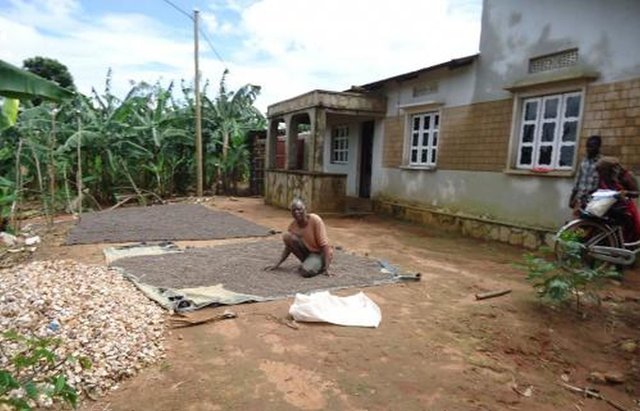
Buhaya agroforestry system [ប្រទេសតង់សានី]
Traditional agroforestry system comprising mixture of banana, coffee, fruit trees, biannual crops, annual crops and timber trees which together optimize the use of soil, moisture and space.
- អ្នកចងក្រង៖ Godfrey Baraba
2. ការពណ៌នាអំពីវិធីសាស្ត្រផ្សព្វផ្សាយ SLM
2.1 ពណ៌នាសង្ខេបខ្លីពីវិធីសាស្ត្រផ្សព្វផ្សាយ
Indigenous knowledge transfer, is a common phenomena in farming societies whereby elders taught younger generations the practical aspects in production and emphasizes the norms and proms in folk story tales.
2.2 ពណ៌នាលម្អិតពិវិធីសាស្ត្រផ្សព្វផ្សាយ
ពណ៌នាលម្អិតពិវិធីសាស្ត្រផ្សព្វផ្សាយ:
Aims / objectives: The main aim of this approach is to improve agricultural production through collaboration of households and the entire community. The approach ensures food security and income with land conservation. The approach is achieved by voluntary learning from the experienced elder farmers. This is achieved by creation of friendly environmental to implement the learning process. The approach is also characterized by traditional prons and norms of the young generation to inherit the elders property.
Methods: The elders spent evening hours to tell farming stories to the younger generation. These stories refer to the success of soil fertility improvement, water resources accessibility and utilization, land use type and farming practices in the community.
Also, practical aspect is attained by involving the younger generation in porting and allocating the land according to land use type.
Stages of implementation: 1. Experienced farmers telling farming stories to the younger while younger listen and ask questions.
2. The elders ask old sayings and elaborate their meaning.
3. Elders demonstrating to the younger, how farming activity are done.
4. The younger implement farming activity and plan for their future.
5.The land is allocated to the younger according to land use type.
6. The younger farmers now are in the position to train their successors.
Role of stakeholders: The major stakeholders are Clan leaders, Head of households, mother, children and hired labour. The roles of Clan leaders are to organize the farming story sessions to the elders and reinforce traditional land norms and proms. The roles of Head of household are to conduct evening farming stories at homestead, encouraging the younger to practice farming by giving incentive according to performance. The roles of the children and hired labour is to work in the head of household farms and ensure proms and proms abides.
Other important information: Nowdays, the approach succeeded to expand cropland beyond grasslands and forestland.
2.3 រូបភាពនៃវិធីសាស្ត្រផ្សព្វផ្សាយ
2.5 ប្រទេស/តំបន់/ទីតាំងកន្លែង ដែលវិធីសាស្ត្រផ្សព្វផ្សាយត្រូវបានអនុវត្តន៍
ប្រទេស:
ប្រទេសតង់សានី
តំបន់/រដ្ឋ/ខេត្ត:
Tanzania
បញ្ជាក់បន្ថែមពីលក្ខណៈនៃទីតាំង:
Bukoba District
Map
×2.7 ប្រភេទនៃវិធីសាស្ត្រផ្សព្វផ្សាយ
- ក្រុមប្រពៃណី/ក្រុមជនជាតិភាគតិច
2.8 គោលបំណង/ទិសដៅសំខាន់នៃវិធីសាស្ត្រផ្សព្វផ្សាយ
The Approach focused mainly on SLM with other activities (Products diversification, livelihood improvements and land resouces inheretence.)
The main aim of the approach is to improve productivity and ensure younger generations productive land ownership and user rights.
The SLM Approach addressed the following problems: Lack of knowledge and skills of farm technologies, collaboration between households and community, eroded/weakened traditional norms, land ownership inequalities.
2.9 លក្ខខណ្ឌអនុញ្ញាត ឬរារាំងការអនុវត្តន៍បច្ចេកទេសដែលស្ថិតនៅក្រោមវិធីសាស្រ្តផ្សព្វផ្សាយ
សង្គម/វប្បធម៌/ និងតម្លៃនៃសាសនា
- រារាំង
Land ownership inequalities, whereby women and girls are not allowed to inheret the clan land.
Treatment through the SLM Approach: Improve women participation in decision making
ភាពអាចរកបាននៃធនធានហិរញ្ញវត្ថុ និងសេវាកម្ម
- រារាំង
Farming activities regarded as volatile assets by most financial institutions
Treatment through the SLM Approach: Introduce and impliment subsidies policy.
បរិបទនៃស្ថាប័ន
- រារាំង
The clan leaders not strong in terms of formal training. Weak reinforcement of laws and bylaws.
Treatment through the SLM Approach: Use extension service staffs to promote informal training.
ក្របខណ្ឌច្បាប់ (សិទ្ធិកាន់កាប់ដីធ្លី កម្មសិទ្ធីប្រើប្រាស់ដីនិងទឹក)
- អំណោយផល
The existing land ownership, land use rights / water rights moderately helped the approach implementation: Individual land ownership without lease smoothing the transfer of land from one parents to offspring. therefore assured perfect training grounds
- រារាំង
Community not well knowledgeable on land laws.
Treatment through the SLM Approach: Train village land law to the community.
ចំណេះដឹងស្តីពី SLM និងការទទួលបានការគាំទ្រផ្នែកបច្ចេកទេស
- រារាំង
Lack of farming technologies transfer.
Treatment through the SLM Approach: Facilitate extension services.
ផ្សេងៗ
- រារាំង
Some plant spps habours pests
Treatment through the SLM Approach: Planting of pecit repelant species. eg Kajaye
3. ការចូលរួម និងតួនាទីរបស់ភាគីពាក់ព័ន្ធ
3.1 អ្នកពាក់ព័ន្ធដែលបានចូលរួមក្នុងវិធីសាស្ត្រផ្សព្វផ្សាយ និងតួនាទីរបស់ពួកគេ
- អ្នកប្រើប្រាស់ដីក្នុងតំបន់/សហគមន៍
Household and hired laborers
Adoption farmers tends to use grups for socilization and participation. The difference between the participation of men and women is that, women train children only, while men can also train hired laborers. Hired labour normally spent the day while folk story conducted at night. Labourers including men and women are disposal to men trainings.Women participate in training at all stages but are not involved in land allocation to the younger generations. Women: Have the rights to produce annual crops and decide on the income from it.
Younger: Are assured of land inheritance from their parents.
laboures: Are paid at the market price.
Poor households: assured food security as work for food, informal land renting i.e paying back the prorate produce.
- រដ្ឋាភិបាលថ្នាក់មូលដ្ឋាន
Provides extension services for up scaling the aproach.
3.2 ការចូលរួមរបស់អ្នកប្រើប្រាស់ដីក្នុងតំបន់/ សហគមន៍ក្នុងតំបន់ក្នុងដំណាក់កាលផ្សេងគ្នានៃវិធីសាស្រ្តផ្សព្វផ្សាយ
| ការចូលរួមរបស់អ្នកប្រើប្រាស់ដីក្នុងតំបន់/សហគមន៍ក្នុងតំបន់ | សូមបញ្ជាក់នរណាត្រូវបានចូលរួម ព្រមទាំងពណ៌នាសកម្មភាពទាំងនោះ | |
|---|---|---|
| ការចាប់ផ្តើម/ការលើកទឹកចិត្ត | គំនិតផ្តួចផ្តើមដោយខ្ឡួនឯង | Household members. To attend and particiapte in appropriate sessions. |
| ការរៀបចំផែនការ | គំនិតផ្តួចផ្តើមដោយខ្ឡួនឯង | Clan leaders: To identify and select problems and find solutios Head of Household: Children. Siblings: Hired labour: |
| ការអនុវត្តន៍ | គំនិតផ្តួចផ្តើមដោយខ្ឡួនឯង | Head of the clan: To organise the sittings. Head of Household:To inform the family and conduct the dialogue Children: To participate in farm production, aceptance of allocated land, Using the located land according to land use type. Siblings: To facilitate divison of labour Hired labor: |
| ការត្រួតពិនិត្យ និងវាយតម្លៃ | គ្មាន | Clan head: To call the meeting Community leaders: To visit farms and other land, To observe and deliver the assessments. |
| Research | អសកម្ម | Few farmers participated in adaptive resarch on Kibanja system 1n 1993. |
3.3 គំនូសបំព្រួញ (ប្រសិនបើមាន)
3.4 ការសម្រេចចិត្តលើការជ្រើសរើសបច្ចេកទេស SLM
សូមបញ្ជាក់តើអ្នកណាជាអ្នកបានសម្រេចចិត្តក្នុងការជ្រើសរើសបច្ចេកទេសដើម្បីយកមកអនុវត្តន៍:
- អ្នកប្រើប្រាស់ដី ដោយមានការគាំទ្រពីអ្នកជំនាញឯកទេស SLM
ចូរពន្យល់:
Indigenous trainings are formalized by extension staffs. Coffee and Vanilla buyers tends to supervise farms for products assurance.
Decisions on the method of implementing the SLM Technology were made by mainly by land users supported by SLM specialists. Extension staffs monitor, evaluate and advise the proper methods up scaling.
4. ជំនួយបច្ចេកទេស ការកសាងសមត្ថភាព និងការគ្រប់គ្រងចំណេះដឹង
4.1 ការកសាងសមត្ថភាព/ បណ្តុះបណ្តាល
តើវគ្គបណ្តុះបណ្តាលបានផ្តល់ឱ្យអ្នកប្រើប្រាស់ដី/អ្នកពាក់ព័ន្ធផ្សេងៗទៀតដែរឬទេ?
បាទ/ចា៎
4.2 សេវាផ្តល់ប្រឹក្សាយោបល់
តើអ្នកប្រើប្រាស់ដីបានទទួលនូវសេវាផ្តល់ប្រឹក្សាដែរ ឬទេ?
បាទ/ចា៎
សូមបញ្ជាក់ប្រសិនបើសេវាកម្មប្រឹក្សាយោបល់ត្រូវបានផ្តល់ឱ្យ:
- នៅលើដីរបស់អ្នកប្រើប្រាស់ដី
ពណ៌នា/ពន្យល់:
Name of method used for advisory service: Train and Visit (T&V); Key elements: Subject Matter Specialist trin field staff on fortnight bases. Field staff visit Progressive farmers and train them, Field Staffs visit Farmers to assess the performance and give feed back to Subject Matter Specialist; The method is very effective under a strong economical situation.
Advisory service is inadequate to ensure the continuation of land conservation activities; Farmer field schools can't reach farming communities with extension staffs based on Ward level.
4.3 ការពង្រឹងសមត្ថភាពស្ថាប័ន (ការអភិរឌ្ឍន៍អង្គភាព)
តើស្ថាប័នទាំងអស់ត្រូវបានបង្កើតឡើង ឬពង្រឹងសមត្ថភាពតាមរយៈវិធីសាស្ត្រផ្សព្វផ្សាយដែរ ឬទេ?
- បាទ/ច៎ា តិចតួច
សូមបញ្ជាក់ថាតើស្ថាប័នត្រូវបានពង្រឹង ឬបង្កើតឡើងនៅត្រឹមកម្រិតណា(ច្រើន)?
- ថ្នាក់មូលដ្ឋាន
- Agricultural advisory services.
4.4 ការត្រួតពិនិត្យ និងវាយតម្លៃ
តើការត្រួតពិនិត្យ និងវាយតម្លៃគឺជាផ្នែកមួយនៃវិធីសាស្ត្រដែរឬទេ?
បាទ/ចា៎
មតិយោបល់:
bio-physical aspects were regular monitored by land users through observations; indicators: activities according to the season.
bio-physical aspects were ad hoc monitored by land users through measurements; indicators: Customary land law, land inheretance protocals.
socio-cultural aspects were regular monitored by land users through observations; indicators: Harvesting season
socio-cultural aspects were ad hoc monitored by other through measurements
economic / production aspects were regular monitored by land users through observations
management of Approach aspects were regular monitored by None through observations
management of Approach aspects were ad hoc monitored by None through measurements
There were few changes in the Approach as a result of monitoring and evaluation: Monitoring and Evaluation component took very minimal attention.
There were no changes in the Technology as a result of monitoring and evaluation
4.5 ការស្រាវជ្រាវ
តើការស្រាវជ្រាវ គឺជាផ្នែកមួយនៃវិធីសាស្រ្តដែរឬទេ?
បាទ/ចា៎
សូមផ្តល់ព័ត៌មានបន្ថែមទៀតឱ្យបានលម្អិត និងចង្អុលបង្ហាញនរណាដែលបានធ្វើការស្រាវជ្រាវ:
Research was carried out on station
5. ថវិកា និងសម្ភារៈឧបត្ថម្ភពីខាងក្រៅ
5.1 ថវិកាប្រចាំឆ្នាំសម្រាប់ផ្សព្វផ្សាយ SLM
ប្រសិនបើចំនួនពិតប្រាកដនៃថវិកាប្រចាំឆ្នាំមិនត្រូវបានដឹងច្បាស់ សូមប្រាប់ពីចន្លោះនៃថវិកានោះ:
- < 2,000
មតិយោបល់ (ឧ. ប្រភពសំខាន់នៃមូលនិធិ/ម្ចាស់ជំនួយចំបង):
Approach costs were met by the following donors: local community / land user(s): 100.0%
5.2 ការគាំទ្រផ្នែកហិរញ្ញវត្ថុ / សម្ភារៈដែលបានផ្តល់ទៅឱ្យអ្នកប្រើប្រាស់ដី
តើអ្នកប្រើប្រាស់ដីបានទទួលការគាំទ្រផ្នែកហិរញ្ញវត្ថ/សម្ភារៈសម្រាប់ការអនុវត្តន៍បច្ចេកទេសដែរឬទេ:
ទេ
5.3 សូមបញ្ជាក់ពីធាតុចូលត្រូវបានផ្តល់បដិភាគ (រួមទាំងកម្លាំងពលកម្ម)
ប្រសិនបើកម្លាំងពលកម្មធ្វើដោយអ្នកប្រើប្រាស់ដី តើវាជាធាតុចូលដ៏សំខាន់មួយដែរ ឬទេ:
- ដោយស្ម័គ្រចិត្ត
មតិយោបល់:
Mainly family labour is the major component of input.
5.4 ឥណទាន
តើឥណទានដែលបានផ្តល់នៅក្រោមវិធីសាស្ត្រផ្សព្វផ្សាយសម្រាប់សកម្មភាព SLM នេះយ៉ាងដូចម្តេច?
ទេ
5.5 ការលើកទឹកចិត្ត ឬវិធីសាស្ត្រដ៏ទៃទៀត
តើមានការលើកទឹកចិត្តផ្សេងទៀត ឬឧបករណ៍ប្រើប្រាស់ដើម្បីលើកកម្ពស់ការអនុវត្តន៍បច្ចេកទេស SLM?
បាទ/ចា៎
បើបាទ/ចា៎ សូមបញ្ជាក់:
Agricultural advisory services.
6. ការវិភាគរកផលប៉ះពាល់ និងសេចក្តីសន្និដ្ឋាន
6.1 ផលប៉ះពាល់នៃវិធីសាស្ត្រផ្សព្វផ្សាយ
តើវិធីសាស្ត្រផ្សព្វផ្សាយបានឱ្យប្រសើរឡើងនូវបញ្ហាកាន់កាប់ដីធ្លី/សិទ្ធិអ្នកប្រើប្រាស់ដែលរារាំងដល់ការអនុវត្ត SLM?
- ទេ
- បាទ/ច៎ា បន្តិចបន្តួច
- បាទ/ច៎ា ជាមធ្យម
- បាទ/ច៎ា បានខ្លាំង
6.2 ការលើកទឹកចិត្តចម្បងៗរបស់អ្នកប្រើប្រាស់ដីសម្រាប់ការអនុវត្តបច្ចេកទេស SLM
- បង្កើនផលិតកម្ម
Diversification asure grand production
- បង្កើនប្រាក់ចំណេញ (សមត្ថភាព) បង្កើនអត្រាចំណេញ
Implementation costs requires on family labour and commitments
- ច្បាប់ និងបទបញ្ជា (ផាកពិន័យ)/ការប្រតិបត្តិ
Farming land inheritance protocals and land norms enforcement are ver crucial components.
6.3 សកម្មភាពផ្សព្វផ្សាយដែលប្រកបដោយចីរភាព
តើអ្នកប្រើប្រាស់ដីអាចធ្វើឱ្យមានចីរភាពនូវអ្វីដែលត្រូវបានអនុវត្តន៍តាមរយៈវិធីសាស្ត្រផ្សព្វផ្សាយដែរឬទេ(ដោយពុំមានការគាំទ្រពីអ្នកខាងក្រៅ)?
- បាទ/ចា៎
ប្រសិនបាទ/ច៎ា សូមរៀបរាប់ថាធ្វើយ៉ាងម៉េច:
It has been in application for very long time, and no signs of retardation observed.
6.4 ភាពខ្លាំង/ គុណសម្បត្តិនៃវិធីសាស្ត្រផ្សព្វផ្សាយ
| ភាពខ្លាំង/ គុណសម្បត្តិ/ ឱកាស ទស្សនៈរបស់បុគ្គលសំខាន់ៗ |
|---|
| Local resource person, obedience and committed community. |
7. ឯកសារយោង និងវេបសាយ
7.1 វិធីសាស្ត្រ/ ប្រភពនៃព័ត៌មាន
- តាមការចុះទីវាល ការស្រាវជ្រាវនៅទីវាល
- ការសម្ភាសន៍ជាមួយអ្នកប្រើប្រាស់ដី
7.2 ឯកសារយោងដែលបានចេញផ្សាយ
ចំណងជើង អ្នកនិពន្ធ ឆ្នាំ ISBN:
http://www.fao.org/nr/kagera/en/
មានប្រភពមកពីណា? ថ្លៃដើមប៉ុន្មាន?
Kagera TAMP project website
ការតភ្ជាប់ និងម៉ូឌុល
ពង្រីកមើលទាំងអស់ បង្រួមទាំងអស់ការតភ្ជាប់

Enhanced mulching in banana and coffee plantation [ប្រទេសតង់សានី]
Application of Thatch and Hyperrhenia Rufa grass mulch in banana and coffee plantation to reduce soil erosion, improve soil fertility and moisture and ensure high productivity
- អ្នកចងក្រង៖ Iwona Piechowiak

Buhaya agroforestry system [ប្រទេសតង់សានី]
Traditional agroforestry system comprising mixture of banana, coffee, fruit trees, biannual crops, annual crops and timber trees which together optimize the use of soil, moisture and space.
- អ្នកចងក្រង៖ Godfrey Baraba
ម៉ូឌុល
គ្មានម៉ូឌុល


